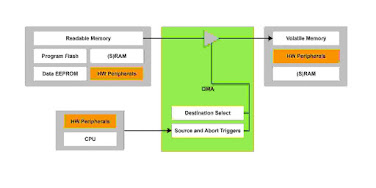Configuration Context Switching
Having multiple
configurations of peripherals can greatly expand the functionality of a
device and lowers unit costs as well as overall BOM cost. However,
changing configurations can be CPU intensive as the registers and
configuration bits for peripherals need to be completely altered, which
could bring about performance issues in some applications.
The
DMA allows for more efficient and robust context-based configuration
through a combination of customizable software- and hardware-based
triggers that permit automated context-based device configuration
independent of the CPU.
System Automation
The DMA
peripheral can be used to automate any system process involving data
transfer. This includes the management of state machine implementations
and reconfiguration of other Core Independent Peripherals (CIPs),
providing you with an efficient method of using a single peripheral in a
variety of ways in response to hardware- or software-defined triggers.
Additionally,
loop-based processes can be automated due to the recursive nature of
calling and processing data, drastically accelerating the throughput of
the device, and by extension, your system.
Arbitrary Waveform Generation
Many
applications require arbitrary waveform data, which can be difficult to
manage with a software-centric system. Arbitrary waveforms are
traditionally generated using complex Digital Signal Processing (DSP)
techniques that require high-end and expensive devices, large amounts of
computation and loads of code.
The DMA can be used to create
these same arbitrary waveforms by reading data sequentially from memory
in the form of a lookup table and feeding this to other peripherals such
as a Pulse-Width Modulator (PWM).

Comments
Post a Comment